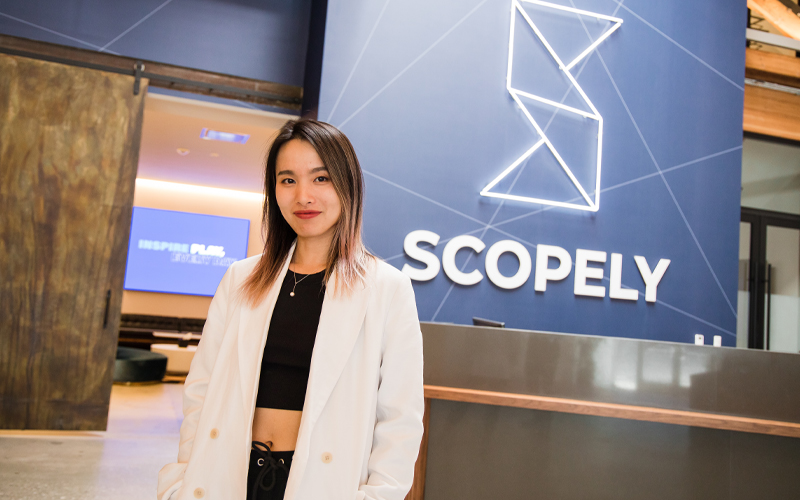Q&A with Yimin
Yimin Gu, Senior Director of Performance Marketing at Scopely, boasts a rich background in mobile acquisition. Her journey includes pivotal roles at studios such as Firefly Games and TapBlaze, where she donned various hats, acquiring extensive expertise in app marketing. Today, at Scopely, Yimin leverages her seasoned insights to evaluate market trends and strategize for long-term success.
Yimin and Kenneth Wong form an energetic Mobile Heroes duo representing Scopely.
Can you describe what it’s like working for an industry giant like Scopely versus your time at smaller independent studios in Firefly Games and TapBlaze?
There are pros and cons for both experiences. In smaller startups, there's a lot more flexibility, and you can move things faster. You also wear multiple hats, allowing you to gain exposure to various aspects of the business. This can accelerate learning and skills development. But at the same time, you have more limited resources at a small company. For example, your data infrastructure might not be as mature, and it’s not uncommon for marketing teams at smaller companies to spend more time pulling data and less time drawing insights and making recommendations. You might be the only person in your department, and you must spend a lot of time figuring things out. Financials at small companies can also be less stable.
By contrast, the financials are more stable at bigger companies, with more job security. You might be more specialized in a specific function and become an expert in this field. You have access to more resources, and you also have access to more learning opportunities, networking opportunities, and so on. But it also might be more competitive and a little more challenging to stand out.
What advice would you give someone wanting to move up in their career in user acquisition from a practitioner to a leadership role?
The first step would be to focus on mastering the fundamentals and excelling at your practice. You have to deeply understand the fundamentals of user acquisition, including all the channels, analytics tools, and performance metrics. Then when you’re there, don’t hesitate to embrace opportunities—especially when they’re presented to you. Also, stay up-to-date and try to adapt to new changes. Remember, it’s an ever-evolving landscape, and marketers need to stay updated on the latest trends and technologies.
What is your most valuable skill as a director of performance marketing at a large mobile game dev like Scopely, compared to a valuable skill needed as a user acquisition manager?
As I said, master the fundamentals as a practitioner. As you move up, there will be more skills to learn. Having a strategic vision is also really important. You have to communicate your vision effectively to other parties, whether it's external clients, managers, or executives. You also have to assess market trends and be able to make decisions and long-term plans. As you start to lead a team, you will have to manage different types of people and care deeply (one of Scopely’s tenets). Understanding and listening to your team can be challenging but rewarding. You learn how best to leverage everyone’s strengths. As a leader, you will set expectations for the team, provide guidance, and create a safe and open environment to work together cohesively. Time management will also be tricky. These are skills that are quite different from working as an individual contributor.
In what other ways (i.e. channels, methods, etc.) outside of in-app user acquisition are mobile marketers putting their money toward today?
More and more companies are trying to expand the scope of user acquisition. I think marketing now depends more on how consumers engage with content. Now, audiences are on different media—for example, connected TV or TikTok. We definitely want to expand our scope to encompass these new emerging platforms. Many CTV partners are integrated with Adjust or AppsFlyer, allowing us to explore more and treat CTV channels as part of the performance marketing approach.
With the deprecation of IDFA, we’re also losing important targeting capabilities. The question now is, how can we run campaigns intelligently, conduct creative analysis, and derive insights? The line between brand and performance marketing is becoming more vague.
What is your bullish case for the mobile gaming market today?
Gaming will still be a promising and lucrative market in the short or mid-term. For example, Monopoly Go and Stumble Guys are both socially driven with multiplayer features that have been enormously successful. This is interesting to me. If a game requires multiple players, it means that if one player is into it, they’ll bring more players along—they’ll invite their friends. Here, the social element of the game empowers marketing for the game. This is creative, and it can expand by leveraging other social platforms.
Generative AI can also be leveraged in game and marketing asset production. In the future, it could greatly improve our efficiency—and the efficiency of the mobile gaming industry.
What will be the next privacy hurdle that user acquisition professionals will face in the coming months?
UA partners are switching to SKAN attribution. Still, there has been a lot of hiccups in this transition. This may be an inevitable trend, but right now, a lot of partners are allowing advertisers to control how we want to do it. Eventually, we might have to move all attribution performance and valuation to the SKAN view.
Google, too, recently rolled out its Privacy Sandbox, something similar to ATT. It’s unclear how it will work as a new attribution framework. Right now, it's still a black box to us. This will likely introduce more friction to cross-platform tracking. For a lot of companies, it’s crucial to track users across platforms. However with this kind of privacy-driven attribution ecosystem, UA will be more complex and require more innovative solutions.
What would you see if we gave you access to a crystal ball to peer into mobile user acquisition's short- and medium-term future?
The privacy change has impacted so many different parties in the advertising ecosystem. I imagine there will be more collaboration between the industry stakeholders—including us, on the advertising and developer sides. With key tech platforms, we may need to establish agreements and best practices for an attribution system that values privacy but is still efficient for advertisers.
AI would also play a crucial role in terms of more sophisticated personalization. With AI, we’ll be better poised to deliver relevant content and ads without relying heavily on user data. But it's just hard to say since the industry is so dynamic. What I say may be completely different in three months.
What are your top three resources for keeping up with the mobile advertising industry?
Everyone probably follows this, but Deconstructor of Fun is a good resource. I also follow some Chinese language resources as well—one of the biggest ones is called “Gaming Grapes [游戏葡萄].” Of course, there are also different Slack communities like Mobile Dev Memo and the one started by our SVP of Ads, Ads R Us. Finally, I also follow the latest updates from peers, industry practitioners, and companies.





















